Mass extinctions & paleoenvironments
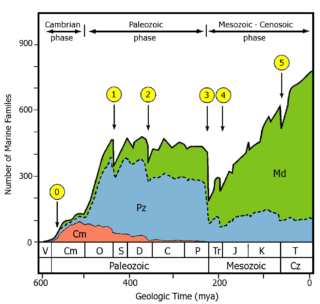
Paleoclimates, including those related to mass extinctions, are being investigated over short and long timescales using differences in the abundances and stable isotope ratios of biomarkers preserved the rock record. Some of the most significant pulses of evolution throughout Earth’s history have coincided with extinction boundary events. The largest five extinction events [end-Ordovician, Frasnian-Famennian (F/F), Permian-Triassic (P/Tr), Triassic/Jurassic (Tr/J) and Cretaceous-Tertiary (K/T)] are usually referred to as “mass extinctions”. No common root or single cause has been identified for these five events, and several aspects remain contentious. There is however a consistent association of large magmatic provinces with all five events, suggesting that volcanism could be a major contributor, but not necessarily the sole cause (for example, the K/T extinction was triggered by major volcanism coinciding with a bolide impact).
Fossil and geochemical evidence tends to suggest that the P/Tr, F/F, K/T and Tr/J transitions were prolonged periods of biotic stress triggered by a combination of tectonically induced hydrothermal and volcanic processes, leading to eutrophic oceans, global warming, sea-level rise and global anoxia. The consequences of abrupt global warming, generally associated with most extinction events, are considered to have been mainly harmful to the biosphere (especially the marine ecosystem) in the geological past. Restoration of the marine ecosystem is a vital process, and several models have been produced that can be used for comparative purposes on a global scale.
Significance of Biomarkers in the Study of Extinction Events
Traces of past life are recorded in the rock record as morphological fossils and/or molecular fossils (biomarkers). Biomarkers carry a wealth of information concerning the composition, ecology and diversity of ancient communities. Many biomarkers encountered in sediments and oils have also been discovered in living organisms (land plants, algae, bacteria and heterotrophs), allowing recognition of their precursor lipids and the establishment of a biomarker connection. Lipids are the molecular components of cell membranes with examples including sterols, hopanols, alcohols, phospho-lipids, ether-lipids & intact lipids. Some of the most valuable biomarkers discovered are 2-methylhopanes, derived from 2-methylbacteriohopanols synthesised by certain cyanobacteria. These diagnostic biomarkers are especially abundant in black shales and other sediments associated with oceanic anoxic events. Another significant set of biomarkers are those originating from the photosynthetic pigments of green/ brown photosynthetic sulfur bacteria. These organisms are strict anaerobes that utilise H2S during photosynthesis to fix CO2 and play a significant role in the sulfur cycle at the chemocline in stratified water columns.
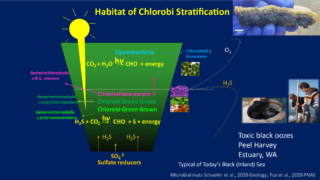
Permian-Triassic
The Permian-Triassic extinction, which occurred 252 million years ago, was the largest extinction event in Earth’s history. 96% of marine and 70% of terrestrial species were wiped out. Research by Prof. Grice and colleagues at WA-OIGC has shown that this extinction event was the result of a number of combined causes, including global warming, the release of large amounts of carbon from methane hydrates, ocean stagnation & marine anoxia, and massive volcanic activity during the formation of the supercontinent Pangaea.
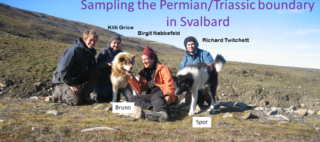
End-Cretaceous event – the Chicxulub impact crater
The end-Cretaceous mass extinction event and its recovery in the actual Chicxulub impact crater has recently been investigated using an organic geochemical and molecular microbial ecological approach. We revealed that within hours after the impact, ocean resurge flooded the crater followed by tsunami bringing terrestrial debris from the surrounding shorelines into the crater. The material contained diagnostic biomarkers of land plants, nitrogen-fixing cyanobacteria and photosynthetic sulfur bacteria from coastal microbial mats. Although the loss of sunlight following the impact led to a massive decline in ocean productivity in the crater waters, land derived biomass and nutrients helped to fuel blooms of unicellular cyanobacteria days to years later. When this nutrient supply decreased, the basin returned to oligotrophic conditions dominated by the abundance of nitrogen-fixing heterocystous cyanobacteria.
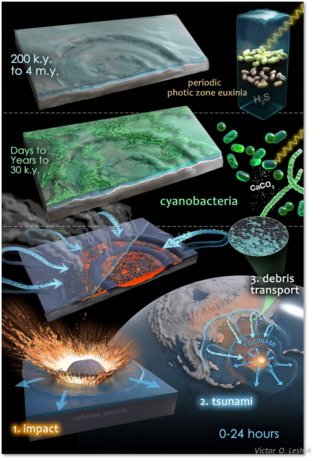
End-Triassic event
From biomarkers and stable isotopes in UK sections we have recently shown that the main extinction phase occurs slightly later in marine strata, where it is coeval with terrestrial extinctions and ocean acidification driven by Central Atlantic Magmatic Province (CAMP)-induced increases in pCO2; these effects should not be conflated with the carbon isotopic excursion.
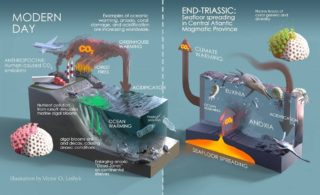
End-Devonian event
The mass extinction event at the end-Devonian period (359 Ma) strongly affected reef-building communities and associated fauna in tropical, marine settings. Work at WA-OIGC has shown that marine settings during the end-Devonian developed anoxic and euxinic bottom waters. The rise of land plants during the Devonian period resulted in an increased input of terrigenous organic matter to the oceans, which sank to the sea floor and was metabolised by bacteria. This consumed the oxygen in the bottom waters, leading to oxygen depletion and the build-up of toxic hydrogen sulfide in the water column.
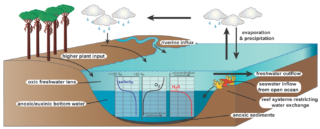
Example publications
Cockell, C.S., Schaefer, B., Wuchter, C., Coolen, M.J.L., Grice, K., Schnieders, L., Morgan, J.V., Gulick, S.P.S., Wittmann, A., Lofi, J., Christeson, G.L., Kring, D.A., Whalen, M.T., Bralower, T.J., Osinski, G.R., Claeys, P., Kaskes, P., de Graaff, S.J., Déhais, T., Goderis, S., Hernandez Becerra, N., Nixon, S., IODP-ICDP Expedition 364 Scientists, 2021. Shaping of the Present-Day Deep Biosphere at Chicxulub by the Impact Catastrophe That Ended the Cretaceous. Frontiers in Microbiology 12, 668240. https://doi.org/10.3389/fmicb.2021.668240
Lounejeva, E., Steadman, J.A., Rodemann, T., Large, R.R., Danyushevsky, L., Mantle, D., Grice, K., Algeo, T.J. 2021. Marcasite at the Permian‐Triassic Transition: A Potential Indicator of Hydrosphere Acidification. In Large Igneous Provinces: A Driver of Global Environmental and Biotic Changes (eds. Ernst, R.E., Dickson, A.J., Bekker, A.). American Geophysical Union, Geophysical Monograph 255. Washington, D.C. p.p. 377-399. https://doi.org/10.1002/9781119507444.ch16
Fox, C.P., Cui, X., Whiteside, J.H., Olsen, P.E., Summons, R.E., Grice, K. 2020. Molecular and isotopic evidence reveals the end-Triassic carbon isotope excursion is not from massive exogenous light carbon. Proceedings of the National Academy of Sciences 117, 30171-30178. https://doi.org/10.1073/pnas.1917661117
Whalen, M.T., Gulick, S.P.S., Lowery, C.M., Bralower, T.J., Morgan, J.V., Grice, K., Schaefer, B., Smit, J., Ormö, J., Wittmann, A., Kring, D.A., Lyons, S., Goderis, S., IODP-ICDP Expedition 364 Scientists. 2020. Winding down the Chicxulub impact: The transition between impact and normal marine sedimentation near ground zero. Marine Geology 430, 106368. https://doi.org/10.1016/j.margeo.2020.106368
Georgiev, S.V., Stein, H.J., Yang, G., Hannah, J.L., Böttcher, M.E., Grice, K., Holman, A.I., Turgeon, S., Simonsen, S., Cloquet, C. 2020. Late Permian–Early Triassic environmental changes recorded by multi-isotope (Re-Os-N-Hg) data and trace metal distribution from the Hovea-3 section, Western Australia. Gondwana Research 88, 353-372. https://doi.org/10.1016/j.gr.2020.07.007
Bralower, T.J., Cosmidis, J., Fantle, M.S., Lowery, C.M., Passey, B.H., Gulick, S.P.S., Morgan, J.V., Vajda, V., Whalen, M.T., Wittmann, A., Artemieva, N., Farley, K., Goderis, S., Hajek, E., Heaney, P.J., Kring, D.A., Lyons, S.L., Rasmussen, C., Sibert, E., Rodríguez Tovar, F.J., Turner-Walker, G., Zachos, J.C., Carte, J., Chen, S.A., Cockell, C., Coolen, M., Freeman, K.H., Garber, J., Gonzalez, M., Gray, J.L., Grice, K., Jones, H.L., Schaefer, B., Smit, J., Tikoo, S.M. 2020. The habitat of the nascent Chicxulub crater. AGU Advances 1, e2020AV000208. https://doi.org/10.1029/2020AV000208
Smith, V., Warny, S., Grice, K., Schaefer, B., Whalen, M.T., Vellekoop, J., Chenot, E., Gulick, S.P.S., Arenillas, I., Arz, J.A., Bauersachs, T., Bralower, T., Demory, F., Gattacceca, J., Jones, H., Lofi, J., Lowery, C.M., Morgan, J., Nuñez Otaño, N.B., O’Keefe, J.M.K., O’Malley, K., Rodríguez-Tovar, F.J., Schwark, L., the IODP–ICDP Expedition 364 Scientists. 2020. Life and death in the Chicxulub impact crater: a record of the Paleocene–Eocene Thermal Maximum. Climate of the Past 16, 1889-1899. https://doi.org/10.5194/cp-16-1889-2020
Bralower, T.J., Cosmidis, J., Heaney, P.J., Kump, L.R., Morgan, J.V., Harper, D.T., Lyons, S.L., Freeman, K.H., Grice, K., Wendler, J.E., Zachos, J.C., Artemieva, N., Chen, S.A., Gulick, S.P.S., House, C.H., Jones, H.L., Lowery, C.M., Nims, C., Schaefer, B., Thomas, E., Vajda, V. 2020. Origin of a global carbonate layer deposited in the aftermath of the Cretaceous-Paleogene boundary impact. Earth and Planetary Science Letters 548, 116476. https://doi.org/10.1016/j.epsl.2020.116476
Lyons, S.L., Karp, A.T., Bralower, T.J., Grice, K., Schaefer, B., Gulick, S.P.S., Morgan, J.V., Freeman, K.H. 2020. Organic matter from the Chicxulub crater exacerbated the K–Pg impact winter. Proceedings of the National Academy of Sciences 117, 25327-2533. https://doi.org/10.1073/pnas.2004596117
Rigo, M., Onoue, T., Tanner, L.H., Lucas, S.G., Godfrey, L., Katz, M.E., Zaffani, M., Grice, K., Cesar, J., Yamashita, D., Maron, M., Tackett, L.S., Campbell, H., Tateo, F., Concheri, G., Agnini, C., Chiari, M., Bertinelli, A. 2020. The Late Triassic Extinction at the Norian/Rhaetian boundary: Biotic evidence and geochemical analysis. Earth-Science Reviews 204, 103180. https://doi.org/10.1016/j.earscirev.2020.103180
Schaefer, B., Grice, K., Coolen, M.J.L., Summons, R.E., Cui, X., Bauersachs, T., Schwark, L., Böttcher, M.E., Bralower, T.J., Lyons, S.L., Freeman, K.H., Cockell, C.S., Gulick, S.P.S., Morgan, J.V., Whalen, M.T., Lowery, C.M., Vajda, V. 2020. Microbial life in the nascent Chicxulub crater. Geology 48, 328-332. https://doi.org/10.1130/G46799.1
Cesar, J., Grice, K. 2019. Molecular fingerprint from plant biomarkers in Triassic-Jurassic petroleum source rocks from the Dampier sub-Basin, Northwest Shelf of Australia. Marine and Petroleum Geology 110, 189-197. https://doi.org/10.1016/j.marpetgeo.2019.07.024
Gulick, S.P.S., Bralower, T.J., Ormö, J., Hall, B., Grice, K., Schaefer, B., Lyons, S., Freeman, K.H., Morgan, J.V., Artemieva, N., Kaskes, P., de Graaff, S.J., Whalen, M.T., Collins, G.S., Tikoo, S.M., Verhagen, C., Christeson, G.L., Claeys, P., Coolen, M.J.L., Goderis, S., Goto, K., Grieve, R.A.F., McCall, N., Osinski, G.R., Rae, A.S.P., Riller, U., Smit, J., Vajda, V., Wittmann, A., the Expedition 364 Scientists. 2019. The first day of the Cenozoic. Proceedings of the National Academy of Sciences 116, 19342-19351. https://doi.org/10.1073/pnas.1909479116
Holman, A.I., Grice, K. 2018. δ13C of aromatic compounds in sediments, oils and atmospheric emissions: A review. Organic Geochemistry 123, 27-37. https://doi.org/10.1016/j.orggeochem.2018.06.004
Spaak, G., Edwards, D.S., Allen, H.J., Grotheer, H., Summons, R.E., Coolen, M.J.L., Grice, K. 2018. Extent and persistence of photic zone euxinia in Middle–Late Devonian seas–Insights from the Canning Basin and implications for petroleum source rock formation. Marine and Petroleum Geology 93, 33-56. https://doi.org/10.1016/j.marpetgeo.2018.02.033
Pagès, A., Barnes, S., Schmid, S., Coveney Jr, R.M., Schwark, L., Liu, W., Grice, K., Fan, H., Wen, H. 2018. Geochemical investigation of the lower Cambrian mineralised black shales of South China and the late Devonian Nick deposit, Canada. Ore Geology Reviews 94, 396-413. https://doi.org/10.1016/j.oregeorev.2018.02.004
Spaak, G., Edwards, D.S., Foster, C.B., Pagès, A., Summons, R.E., Sherwood, N., Grice, K. 2017. Environmental conditions and microbial community structure during the Great Ordovician Biodiversification Event; a multi-disciplinary study from the Canning Basin, Western Australia. Global and Planetary Change 159, 93-112. https://doi.org/10.1016/j.gloplacha.2017.10.010
Cesar, J., Grice, K. 2017. δ13C of polycyclic aromatic hydrocarbons to establish the facies variations in a fluvial deltaic Triassic record (Dampier sub-Basin, Western Australia). Organic Geochemistry 107, 59-68. https://doi.org/10.1016/j.orggeochem.2017.03.001
Grotheer, H., Le Métayer, P., Piggott, M.J., Lindeboom, E.J., Holman, A.I., Twitchett, R.J., Grice, K. 2017. Occurrence and significance of phytanyl arenes across the Permian-Triassic boundary interval. Organic Geochemistry 104, 42-52. https://doi.org/10.1016/j.orggeochem.2016.12.002
Pagès, A., Schmid, S., Edwards, D., Barnes, S., He, N., Grice, K. 2016. A molecular and isotopic study of palaeoenvironmental conditions through the middle Cambrian in the Georgina Basin, central Australia. Earth and Planetary Science Letters 447, 21-32. https://doi.org/10.1016/j.epsl.2016.04.032
Whiteside, J.H., Grice, K. 2016. Biomarker records associated with mass extinction events. Annual Review of Earth and Planetary Sciences 44, 581-612. https://doi.org/10.1146/annurev-earth-060115-012501
Naeher, S., Grice, K. 2015. Novel 1H-Pyrrole-2,5-dione (maleimide) proxies for the assessment of persistent photic zone euxinia. Chemical Geology 404, 100-109. https://doi.org/10.1016/j.chemgeo.2015.03.020
Tulipani, S., Grice, K., Greenwood, P.F., Schwark, L., Summons, R.E., Böttcher, M.E., Foster, C.B. 2015. Molecular proxies as indicators of freshwater incursion-driven salinity stratification. Chemical Geology 409, 61-68. https://doi.org/10.1016/j.chemgeo.2015.05.009
Tulipani, S., Grice, K., Greenwood, P.F, Haines, P., Sauer, P., Schimmelmann, A., Summons, R.E., Foster, C.B. Böttcher, M.E., Playton, T., Schwark, L. 2015. Changes in palaeoenvironmental conditions in Late Devonian Reef systems from the Canning Basin, WA: A biomarker and stable isotope approach. Gondwana Research 28, 1500-1515. https://doi.org/10.1016/j.gr.2014.10.003
Williford, K.H., Grice, K., Holman, A., McElwain, J.C., 2014. An organic record of terrestrial ecosystem collapse and recovery at the Triassic-Jurassic boundary in East Greenland. Geochimica et Cosmochimica Acta 127, 251-263. https://doi.org/10.1016/j.gca.2013.11.033
Jaraula, C.M.B, Grice, K., Twitchett, R.,J., Böttcher, M.E., Le Metayer, P., Dastidar, A.G., Opazo, L.F. 2013. Elevated pCO2 leading to Late Triassic extinction, persistent photic zone euxinia, and rising sea levels. Geology 41, 955-958. https://doi.org/10.1130/G34183.1
Luo, G., Wang, Y., Grice, K., Jia, C., Xie, S. 2013. Microbial-algal community changes during the latest Permian ecological crisis: Evidence from lipid biomarkers at Cili, South China. Global and Planetary Change 105, 36-51. https://doi.org/10.1016/j.gloplacha.2012.11.015
Melendez, I., Grice, K., Schwark, L. 2013. Exceptional preservation of palaeozoic steroids in a diagenetic continuum. Nature Scientific Reports 3, 2768. https://doi.org/10.1038/srep02768
Melendez, I., Grice, K., Trinajstic, K., Ladjavardi, M., Thompson, K., Greenwood, P.F. 2013. Biomarkers reveal the role of photic zone euxinia in exceptional fossil preservation: An organic geochemical perspective. Geology 41, 123-126. https://doi.org/10.1130/G33492.1
Metcalfe, I., Nicholl, R.S., Willink, R., Ladjavardi, M., Grice, K. 2013. Early Triassic (Induan-Olenekian) conodont biostratigraphy, global anoxia, carbon isotope excursions and environmental perturbations: New data from Western Australian Gondwana. Gondwana Research 23, 1136-1150. https://doi.org/10.1016/j.gr.2012.07.002
Hays, L., Grice, K., Foster, C.B., Summons, R.E. 2012. Biomarker and isotopic trends from a Permian-Triassic sedimentary section at Kap-Stosch, Greenland. Organic Geochemistry 43, 67-82. https://doi.org/10.1016/j.orggeochem.2011.10.010
Nabbefeld, B., Grice, K., Schimmelmann, A., Summons, R.E., Troitzsch, A., Twitchett, R.J. 2010. A comparison of thermal maturity parameters between freely extracted hydrocarbons (Bitumen I) and a second extract (Bitumen II) from within the kerogen matrix of Permian and Triassic sedimentary rocks. Organic Geochemistry 41, 78-87. https://doi.org/10.1016/j.orggeochem.2009.08.004
Nabbefeld, B., Grice, K., Schimmelmann, A., Sauer, P.E., Böttcher, M.E., Twitchett, R.J. 2010. Significance of δDkerogen, δ13Ckerogen and δ34Spyrite from several Permian/Triassic (P/Tr) sections. Earth and Planetary Science Letters, 295, 21-29. https://doi.org/10.1016/j.epsl.2010.03.015
Nabbefeld, B., Grice, K., Twitchett, R.J., Summons, R.E., Hays, L., Böttcher, M.E., Muhammad, A. 2010. An integrated biomarker, isotopic and palaeoenvironmental study through the Late Permian event at Lusitaniadalen, Spitsbergen. Earth and Planetary Science Letters 291, 84-96. https://doi.org/10.1016/j.epsl.2009.12.053
Nabbefeld, B., Grice, K., Summons, R.E., Hays, L., 2010. Significance of polycyclic aromatic hydrocarbons (PAHs) in Permian/Triassic boundary sections. Applied Geochemistry 25, 1374-1382. https://doi.org/10.1016/j.apgeochem.2010.06.008
Grice, K., Lu, H., Atahan, P., Hallmann, C., Asif, M., Greenwood, P.F., Tulipani, S., Maslen, E., Williford, K.H., and Dodson, J. 2009. New insights into the origin of perlyene in geological samples. Geochimica et Cosmochimica Acta 73, 6531-6543. https://doi.org/10.1016/j.gca.2009.07.029
Fenton, S., Grice, K., Twitchett, R., Bottcher, M., Looy, C.V., Nabbefeld, B. 2007. Changes in Biomarker Abundances and Sulfur Isotopes of Pyrite across the Permian-Triassic (P/Tr) Schuchert Dal Section (East Greenland). Earth and Planetary Science Letters 262 230-23. https://doi.org/10.1016/j.epsl.2007.07.033
Grice, K., Nabbefeld, B., Maslen, E. 2007. Source and Significance of Selected Polycyclic Aromatic Hydrocarbons in Sediments (Hovea-3 well, Perth Basin, Western Australia) Spanning the Permian-Triassic Boundary. Organic Geochemistry 38, 1795-1803. https://doi.org/10.1016/j.orggeochem.2007.07.001
Grice, K., Cao, C., Love, G.D., Bottcher, M.E., Twitchett, R.J., Grosjean, E., Summons, R.E., Turgeon, S., Dunning, W.J., Yin, Y. 2005. Photic zone euxinia during the Permian-Triassic Superanoxic event. Science 307, 706-709. https://doi.org/10.1126/science.1104323
Grice, K., Twitchett, R.J., Alexander, R., Foster, C.B., Looy, C. 2005. A potential biomarker for the Permian-Triassic ecological crisis. Earth and Planetary Science Letters 236, 315-321. https://doi.org/10.1016/j.epsl.2005.05.008
Grice, K., Backhouse, J., Alexander R., Marshall, N., Logan, G.A. 2005 Correlating terrestrial signatures from biomarker distributions, δ13C , and palynology in fluvio-deltaic deposits from NW Australia (Triassic-Jurassic). Organic Geochemistry 36, 1347-1358. https://doi.org/10.1016/j.orggeochem.2005.06.003
Grice, K., Summons, R.E., Grosjean, E., Twitchett, R., Dunning, W.J., Wang, S., Bottcher, M.E. 2005. Depositional conditions of the Northern onshore Perth basin (Basal Triassic). The APPEA Journal 45, 263-273. https://doi.org/10.1071/AJ04023
Thomas, B.M., Willink, R.J., Grice, K., Twitchett, R.J., Purcell, R.R., Archbold, N.W., George, A.D., Tye, S., Alexander, R., Foster, C.B., Barber, C.J. 2004. Unique marine Permian/Triassic boundary section from Western Australia. Australian Journal of Earth Sciences. 51, 423-430. https://doi.org/10.1111/j.1400-0952.2004.01066.x
Grice K., Gibbison, R., Atkinson, J.E., Eckardt, C.B., Schwark, L., Maxwell, J.R. 1996. 1H-pyrrole-2,5,-diones (maleimides of anoxygenic photosynthesis in paleowater columns. Geochimica et Cosmochimica Acta 60 3913-3924. https://doi.org/10.1016/0016-7037(96)00199-8
